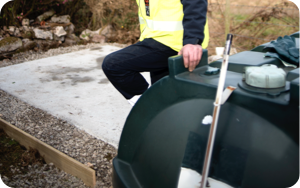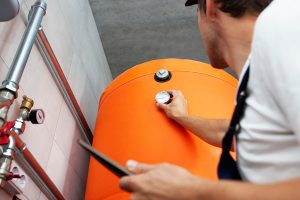If your heating oil tank is old or damaged, you might be wondering how to go about removing it from your home. Or perhaps you want to move your tank from one position to another on your property.
Whether you’re replacing your heating oil tank or simply relocating it, it’s important that you plan this process carefully. There are a number of safety issues and rules and regulations that you’ll need to take into account, so it’s best to get the experts in to help.
Here, we bring you guidance and advice on removing your domestic oil tank, including:
- Signs that your current tank may need to be replaced
- What to consider when relocating an existing tank
- How to dispose of old tanks
- How to choose and install a new heating oil storage solution
Is it time to remove and replace your heating oil tank?
With certain appliances or pieces of equipment in your home, you might wait until they break before you replace them. With heating oil tanks, it’s important to take action as soon as you spot it failing.
A leaky tank could pollute the surrounding land and it may even contaminate private or public water sources. The cost of cleaning up a heating tank spillage can be considerable, and there is also a small risk that a faulty tank could lead to fire and explosions.
Therefore, you should keep a close eye on the condition of your oil tank and remove and replace it when you spot problems. The main things to look out for are:
- Cracks or holes in the casing – This can indicate weaknesses that could lead to leaks
- Dents, bulges or scratches – Especially around valves, pipes and seams
- Signs of a leak – If you think you spot oil leaking from your tank, take action immediately
- Discolouration – Plastic tanks can bleach in the sun, meaning their colour starts to fade. When this happens, the plastic becomes more brittle and prone to breaking.
- Rust – The discolouration of metal tanks can also be a cause for concern. If these containers start to rust, areas of weakness can develop.
As well as checking your heating oil tank regularly yourself, it’s important that it gets inspected by an OFTEC registered heating engineer each year. A qualified technician will carry out tank inspections as part of your boiler service, alerting you to any warning signs and advising you when it’s time to get a tank replacement.
According to OFTEC, oil tanks have an expected working life of around 20 years. If used beyond this time, the risk of failure rises. However, factors such as poor installation or a lack of maintenance can shorten an oil tank’s lifespan, so it’s important to be vigilant no matter how old your heating oil tank is.
Find out more about our boiler servicing.
Can you remove an oil tank?
Perhaps you’re planning a property extension and need to move your heating oil tank in order to make room for it. Or maybe you’re replacing an old tank and want to install your new one in a different location that’s safer or more convenient.
When you’re deciding where to relocate your tank to, you’ll need to follow rules designed to limit the risks of oil spills. It’s therefore important to get an OFTEC registered technician to carry out an assessment of the site and to give it the all clear.
We’ve listed some of the regulations around fire and water safety when storing heating oil on your property below. You can find more details about Oil Tank Regulations on gov.uk.
Fire Safety
- Heating oil tanks should be a minimum of 1.8 metres away from non-fire rated buildings or structures. This includes: garden sheds, and the same distance from openings including windows and doors in fire-rated buildings.
- Oil tanks should be at least 760mm away from non-fire rated boundaries like wooden fences.
- If the above requirements can not be met, a protective barrier with a fire rating of at least 30 minutes should be used.
- In some cases, tanks can be located within buildings, like outhouses or garages. However, in these scenarios, the tanks have to be contained within a chamber with a fire rating of 60 minutes.
Fire Safety
- When a tank is situated near water, it should have a suitable base to rest on. The base should be constructed of concrete, stonework or paving stones. In addition, the base must be capable of supporting the weight of the container and large enough so that it extends 300mm beyond the edge of the tank on all sides.
Security
- As heating oil tanks are generally stored above ground, it pays to be aware of, and to take action, to minimise fuel theft.
- Ideally choose a location as far from the road as possible
- Remember that the tank does need to be accessible for it to be refilled.
- If possible choose a spot that is visible from your home
- Take out heating oil tank insurance as this is not covered in standard household insurance policies.
Discover more tips to protect your heating oil from theft.
Moving an oil tank
Once you’ve chosen a suitable site with an appropriate base for your oil tank, you’ll need to arrange the move itself. Before you move the tank, be sure to use up most of the oil left inside. Leave the tank nearly empty but not completely empty. Running your tank down until it’s completely empty can cause problems for your boiler, so it’s best not to do this.
- An expert engineer can then come in to complete the oil tank relocation. Firsty, the engineer will drain any oil left in your tank. Clean oil can be kept in a holding vessel and then fed back into your tank once it’s in its new position.
- Any contaminated oil will be safely disposed of at a licensed site. Once the fuel has been removed, the tank will be cleaned and disconnected.
- The tank will then be repositioned and installed in its new location, before being connected to your fuel line. In order for this last step to happen, your existing fuel line will either need to be extended or replaced, depending on the new location of the tank. Installing the new fuel line can be the most disruptive part of the process, so it’s important that you plan for it carefully.
How to dispose of old oil tank
If you’re getting rid of your old tank, the engineer will either take it away whole or, if it is too big to do this, cut it up and remove it in sections. The engineer should then take the materials to a recycling centre. Whether tanks are plastic or metal, they can be recycled as long as they are empty and have been cleaned. So it’s worth making sure that your contractor will recycle your tank before you agree to use their services.
How to choose and install a new oil tank
If you’re getting a new heating oil tank to replace your old one, it’s important to choose wisely. Getting a high-quality tank will help ensure you get many years of trouble-free use from it.
You can order tanks in varying sizes to suit your property and should always purchase a bunded tank to adhere to current oil tank regulations. A bund is a popular safety feature that acts as a secondary containment system, by preventing any fuel that may leak from the tank from escaping into the environment.
For added convenience, you could choose a tank that comes with a pre-installed fuel monitor that allows you to keep track of your oil usage more easily. Using an oil tank gauge can also help you to detect any fuel leaks more quickly.
Whichever tank you decide to go for, it’s really important to get it installed correctly. To do this, make sure you use an OFTEC registered tank installation engineer. They will ensure that the tank is placed in a suitable location and is connected properly and securely. Getting this right now could save you unnecessary hassle and expense further down the line.





